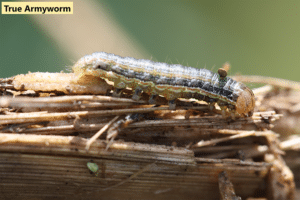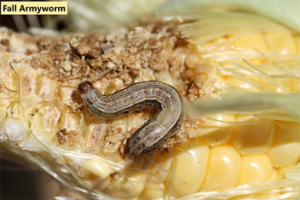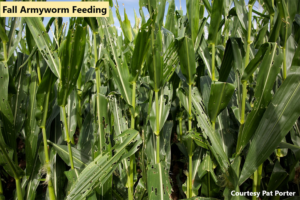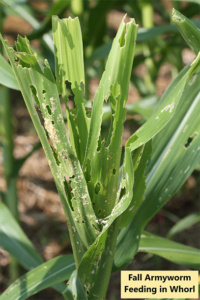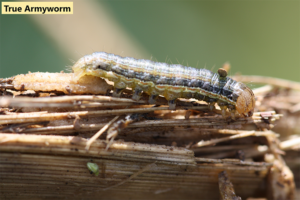Management options
| Insecticide (Trade Names) for FALL ARMYWORM | Lb Active Ingredient per Acre | Amount Formulation per Acre | Performance Rating |
|---|---|---|---|
| bifenthrin (Brigade 2E, Discipline 2E, Fanfare 2E) | 0.063 - 0.10 | 4 - 6.4 oz | 6 |
| carbaryl (Sevin XLR Plus 4) | 1 - 2 | 32 - 64 oz | 4 |
| chlorantraniliprole (Vantacor 5 SC) | 0.047 - 0.067 | 1.2 - 1.71 oz | 9 |
| chlorantraniliprole, bifenthrin (Elevest) | See label | 5.6 - 9.6 oz | 9 |
| chlorantraniliprole, λ-cyhalothrin (Besiege) | see label | 6 - 10 oz | 9 |
| methomyl (Lannate LV 2.4)* | 0.225 - 0.3 | 12 - 16 oz | 7 |
| methoxyfenozide (Intrepid 2F) | 0.6 - 0.125 | 4 - 8 oz | 7 |
| permethrin (Pounce 3.2E) | 0.1 - 0.2 | 4 - 8 oz | 5 |
| spinetoram (Radiant SC 1) | 0.02 - 0.05 | 3 - 6 oz | 8? |
| spinosad (Blackhawk 36% WDG) | 0.04 - 0.07 | 1.7 - 3.3 oz | 7 |
| β-cyfluthrin (Baythroid XL 1) | 0.02 | 2.8 oz | 6 |
| γ-cyhalothrin (Declare 1.25) | 0.01 - 0.015 | 1.02 - 1.54 oz | 6 |
| λ-cyhalothrin (Warrior II) | 0.02 - 0.03 | 1.28 - 1.92 oz | 6 |
| Z-cypermethrin (Mustang Maxx 0.8E) | 0.02 - 0.025 | 3.2 - 4 oz | 6 |
- Production of an early crop and preservation of beneficial insects will reduce the risk of armyworm outbreaks.
- Several of the new Bt corn technologies are effective at controlling fall armyworms in the whorls and ears.
